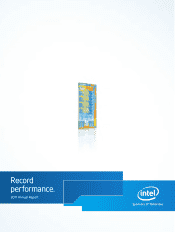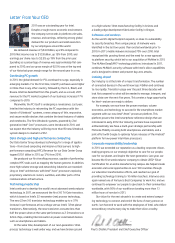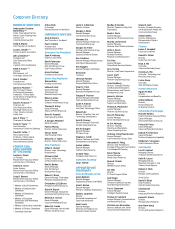Intel 2011 Annual Report Download - page 3
Download and view the complete annual report
Please find page 3 of the 2011 Intel annual report below. You can navigate through the pages in the report by either clicking on the pages listed below, or by using the keyword search tool below to find specific information within the annual report.
Letter From Your CEO
2011 was an outstanding year for Intel.
Despite a tough macro-economic environment,
the company set records in platform unit sales,
revenue, and earnings, refl ecting strong global
demand for our products and solid execution
by our employees around the world.
We delivered revenue of $54.0 billion, up 24% compared to
2010. Net income rose to $12.9 billion, up 13% from 2010, and
earnings per share rose to $2.39, up 19% from the prior year.
Spending as a percentage of revenue was approximately fl at com-
pared to 2010, and our gross margin of 62.5% was at the top end
of our historical gross margin range for the second year in a row.
Continuing PC growth
In 2011, the global demand for PCs continued to surge, especially in
emerging markets. For the fi rst time, total PC purchases were higher
in China than in any other country, followed by the U.S., Brazil, and
Russia. Intel has benefi ted from this growth, and as a result, 2011
revenue for the PC market segment of our business increased 17%
compared to 2010.
Meanwhile, the PC itself is undergoing a renaissance. Last year,
Intel led the industry in reinventing the PC experience with the
launch of Ultrabook™ systems, a new category of thin, responsive,
and secure mobile devices that combine the best features of tablets
and notebooks. The fi rst Ultrabook systems, powered by 2nd
generation Intel® Core™ processors, were introduced in 2011, and
we expect that the industry will bring more than 80 new Ultrabook
system designs to market in 2012.
Data storage and high-performance computing
Our Data Center Group develops technology for a range of applica-
tions—from cloud computing and mission-critical servers to high-
performance computing (HPC). Revenue for our Data Center Group
topped $10.1 billion in 2011, up 17% from 2010.
We produced our fi rst terafl op processor, capable of performing
complex HPC tasks such as mapping the human genome. In addition,
more high-volume storage and networking industries are standard-
izing on Intel® architecture, with Intel® Xeon® processors replacing
proprietary solutions in routers, switches, and other parts of the
communications infrastructure.
Technology leadership
Intel continues to develop the world’s most advanced semiconductor
technology. In 2011, we announced the fi rst 3-D Tri-Gate transistor,
which is based on Intel’s 22-nanometer (nm) process technology.
The new 22nm 3-D transistor technology enables up to a 37%
increase in performance at low voltage versus Intel’s 32nm planar
transistors. Alternatively, the new transistors consume less than
half the power when at the same performance as 2-D transistors on
32nm chips, enabling Intel innovation in power-constrained devices
such as smartphones and tablets.
At the same time, development of our next-generation 14nm
process technology is well under way, and we have broken ground
on a high-volume 14nm manufacturing facility in Arizona and
a leading-edge development fabrication facility in Oregon.
Software and services
As the world’s digital footprint expands, so does its vulnerability
to security breaches. More unique pieces of malware were
identifi ed in the last two years than existed worldwide prior to
2010. In 2011, mobile malware increased 70% over 2010. Intel
recognized this growing threat and the need for a new approach
to platform security, which led to our acquisition of McAfee in 2011.
The McAfee DeepSAFE* technology platform, introduced in 2011,
combines McAfee’s security software with Intel’s silicon capabilities
and is designed to detect and prevent day-zero attacks.
Looking ahead
Our industry is at the brink of a major transformation. The number
of connected devices in the world now tops 4 billion and continues
to rise rapidly. Transistor usage over the past three decades will
look fl at compared to what will be needed to manage, interpret, and
store data over the next fi ve years. This creates a huge opportunity
for Intel—and we are ready to deliver.
For example, we now have the power envelope, volume
economics, and technology to succeed in the smartphone market
segment with our new Intel® Atom™ processor platform. This
platform powers the Intel smartphone reference design that we
introduced in early 2012. Our industry partners have responded
enthusiastically. We have a multi-year strategic partnership with
Motorola Mobility covering both smartphones and tablets, and a
joint effort with Google to optimize future releases of the Android*
platform for low-power Intel Atom processors.
Corporate responsibility leadership
In 2011, we extended our reputation as a leading corporate citizen,
making progress on our strategic objective to care for our people,
care for our planet, and inspire the next generation. Last year, we
became the fi rst semiconductor company to obtain LEED* Silver
Certifi cation for an entire manufacturing campus. We helped create
economic and social opportunities in over 100 countries through
our education transformation efforts, and reached our goal of
providing technology training to 10 million teachers. Intel was once
again named one of Fortune’s Best Companies to Work For, and we
continued to empower our people to give back to their communities
worldwide, with 50% of our workforce donating more than 1.1
million hours of service in 2011.
Our vision for the next decade is to create and extend comput-
ing technology to connect and enrich the lives of every person on
earth. I am honored to work with the employees of Intel, who deliver
extraordinary results every day to make that vision a reality.
Paul S. Otellini, President and Chief Executive Offi cer










